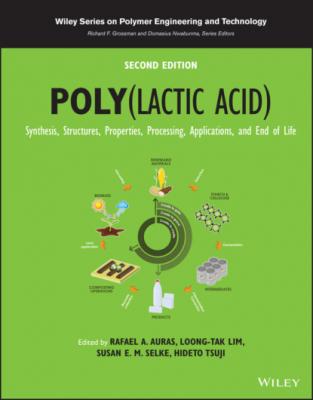Poly(lactic acid). Группа авторов
Читать онлайн.| Название | Poly(lactic acid) |
|---|---|
| Автор произведения | Группа авторов |
| Жанр | Химия |
| Серия | |
| Издательство | Химия |
| Год выпуска | 0 |
| isbn | 9781119767466 |
Although the fermentation industry can be considered traditional, new technologies may quickly find uses. The rapid commercial application of filtration techniques such as in membrane bioreactors in wastewater treatment and the fast introduction of nanofiltration for making process water from river water are examples. The discovery of ionic liquids with high distribution coefficients for lactic acid in dilute solutions may lead to breakthroughs [67]. New steam boiler concepts that can handle residues can drastically change DSP layout in energy‐efficient integrated biorefineries.
1.2.6 Quality/Specifications of Lactic Acid
The dehydration of lactic acid to make the prepolymer should start with an –OH to –COOH ratio of 1 : 1. All other components with –OH and –COOH functionality disrupt the stoichiometric balance and may be incorporated as comonomers during prepolymerization, which limits the final lactide production yield from lactic acid. Little public information is available on the technical and economic relationship between lactic acid quality and lactide synthesis. Only a few patents mention the effect of metal impurities on racemization [68, 69]. Stereochemical purity is one of the key parameters determining lactic acid purity.
Lactic acid purified by crystallization may be taken as the benchmark in lactide manufacture, but the expected unfavorable economics of making crystalline acid in relation to mother liquor processing may prevent its commercial use for lactide/PLA. The next level of quality with the right commercial relevance is heat‐stable lactic acid. Heat stability puts constraints on the content of sugar, and thus on the DSP method used in the process. It is unlikely that suitable acid for making lactide will contain sugar because of the high temperatures involved (see the next section) and the well‐known practical decomposition problems when sugars are cracked. In practice, this means that color, or actually heated color (color after heating of the acid), is an important indicator for the suitability of the acid for lactide/PLA production [6, 70]. The appeal for lactic acid with little or no sugar and the DSP methods mentioned in practice lead to demands for separation methods that are similar for sugar and other heavy components such as proteins, amino acids, and polysaccharides.
It is expected that the desired quality of lactic acid for making lactide/PLA will evolve, with overall process yields and economics as the criteria.
1.3 LACTIDE
1.3.1 Physical Properties of Lactide
The dehydrated, cyclic dimer of lactic acid is commonly called lactide (3,6‐dimethyl‐1,4‐dioxane‐2,5‐dione). Due to the two asymmetric carbon atoms in the molecule, lactide exists in three different forms (Figure 1.6).
FIGURE 1.6 The three diastereomeric structures of lactide (3,6‐dimethyl‐1,4‐dioxane‐2,5‐dione).
In addition to the three diastereomeric structures mentioned above, also a racemate of D‐lactide and L‐lactide exists: rac‐lactide or D,L‐lactide (Table 1.3).
1.3.2 Production of Lactide
The synthesis of lactide was first described by Pelouze in 1845 [71]. He investigated the self‐esterification of lactic acid by heating and driving off water and obtained a prepolymer that was no longer fully miscible with water. Upon continued heating of the prepolymer, he noticed that in a certain distillate fraction nice crystals were formed. He was able to deduce the chemical formula and gave the name “lactid” to the substance. An improved procedure was described in a patent by Gruter and Pohl in 1914 [72]. Lactic acid was self‐esterified at 120–135°C, and air was drawn in to remove the water. Next, zinc oxide was added as a catalyst and lactide was distilled off under vacuum at 200°C. In practice, modern industry cannot dispense with this concept of thermal catalytic depolymerization for lactide production. A major step forward was the use of a tin catalyst, a frequently used coordinating catalyst in polymerizations, in the process. The general scheme of lactide manufacture including the purification is shown in Figure 1.7.
TABLE 1.3 Physical Properties of the Lactides
| Unit | D‐Lactide | L‐Lactide [6] | meso‐Lactide | rac‐Lactide | |
|---|---|---|---|---|---|
| CAS number | 13076‐17‐0 | 4511‐42‐6 | 13076‐19‐2 | 116559‐43‐4 | |
| Molecular weight | g/mol | 144.12 | 144.12 | 144.12 | — |
| Melting point | °C | 96–97 | 96 | 53 [64] | 125 [6] |
| Boiling point | °C | — | — | — | 142 (20 mbar) [64] |
| Heat of fusion | J/g | — | 146 | 128 [64]; 118 [6] | 185 [6] |
| Heat of vaporization | kJ/mol | — | 63 | — | — |
| Solid density | g/mL | — | 1.32–1.38 | 1.32–1.38 [6] | — |
| Liquid viscosity | mPa s | — | 2.71 (110°C); 2.23 (120°C); 1.88 (130°C) | — | — |
FIGURE 1.7 Schematic illustration of lactide manufacture by thermal catalytic depolymerization of lactic acid oligomers.
In the past two decades, several papers have appeared on lactide manufacture [73, 74].
